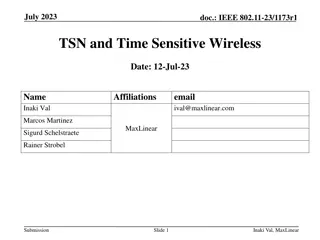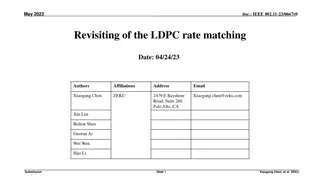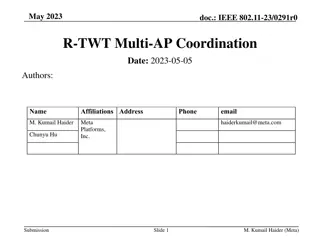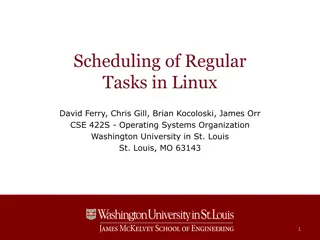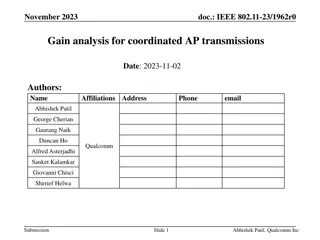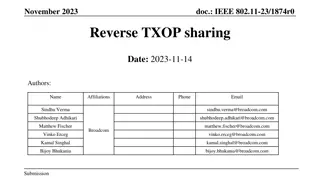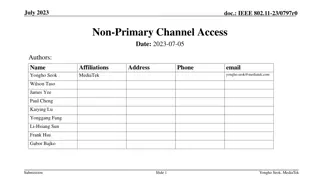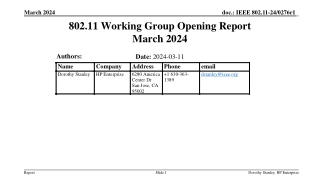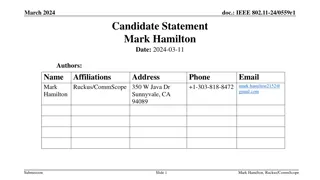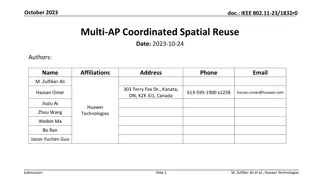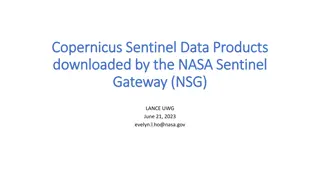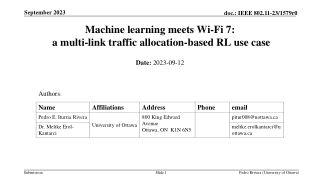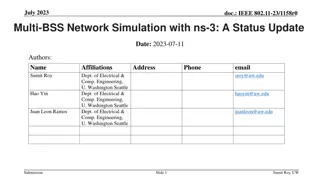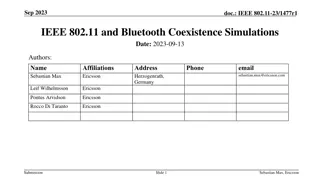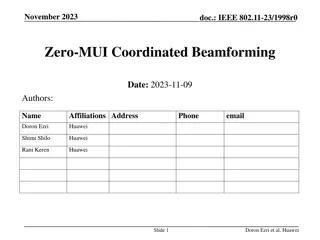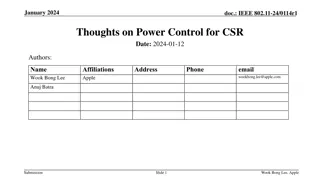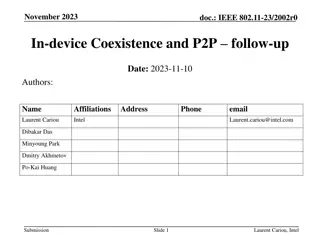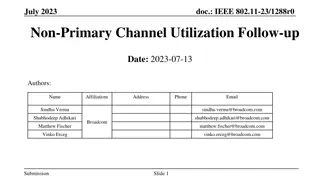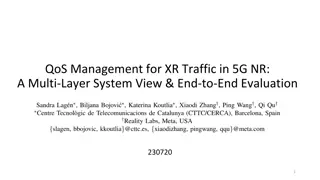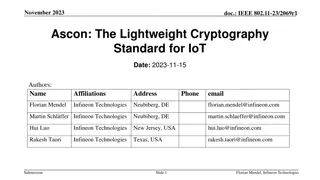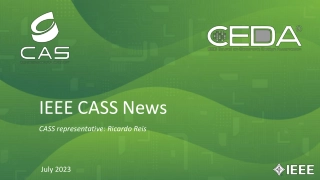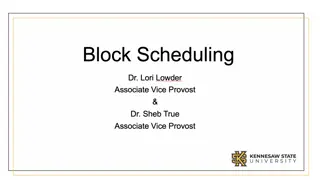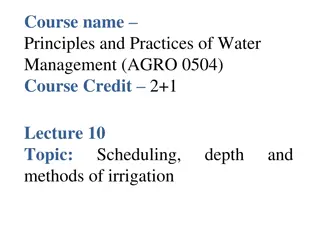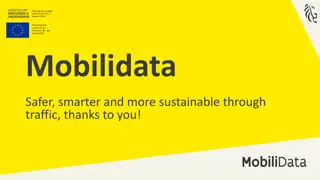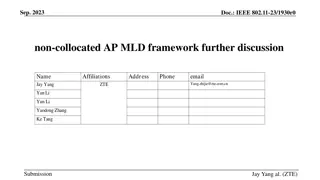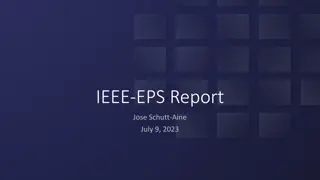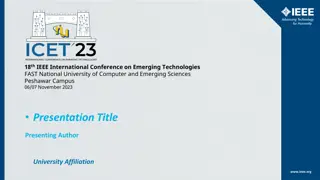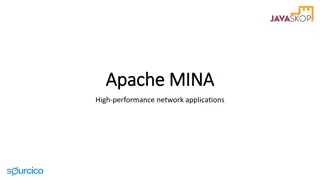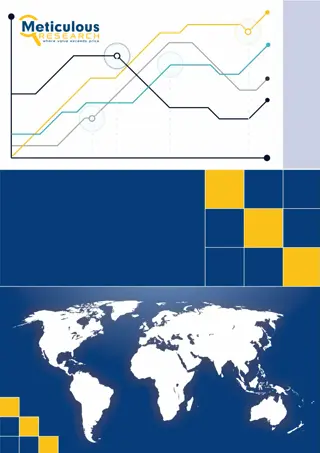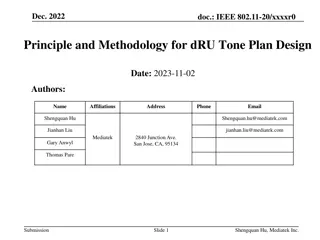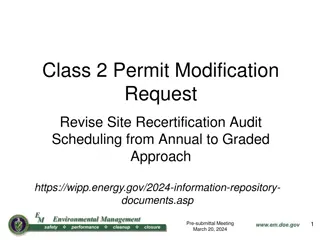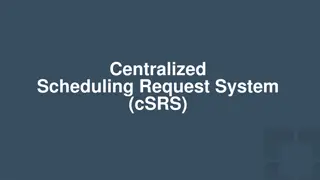Enhanced Scheduling Method for Low Latency Traffic in IEEE 802.11-24/0091r1
This document presents an enhanced scheduling method for handling low latency traffic in IEEE 802.11 networks. It focuses on supporting deterministic and event-based latency-sensitive traffic, addressing challenges in scheduling and resource allocation. The proposed method aims to improve the reliability and efficiency of handling such traffic types within wireless communication systems.
Enhanced Scheduling Method for Low Latency Traffic in IEEE 802.11-24/0091r1
PowerPoint presentation about 'Enhanced Scheduling Method for Low Latency Traffic in IEEE 802.11-24/0091r1'. This presentation describes the topic on This document presents an enhanced scheduling method for handling low latency traffic in IEEE 802.11 networks. It focuses on supporting deterministic and event-based latency-sensitive traffic, addressing challenges in scheduling and resource allocation. The proposed method aims to improve the reliability and efficiency of handling such traffic types within wireless communication systems.. Download this presentation absolutely free.
Presentation Transcript
January 2024 doc.: IEEE 802.11-24/0091r1 Enhanced Scheduling Method for Low Latency Traffic Follow up Date: 2024-01-12 Authors: Name Affiliations Address Phone email serkucuk@ofinno.com Serhat Erkucuk Reston, VA 20190 Jeongki Kim Leonardo Lanante Ofinno Jiayi Zhang Tuncer Baykas Submission Slide 1 Serhat Erkucuk, Ofinno
January 2024 doc.: IEEE 802.11-24/0091r1 Introduction Enabling at least one mode of operation capable of improving the tail of the latency distribution and jitter compared to EHT MAC/PHY operation, with mobility between BSSs is one of the main targets for enhancing reliabilityin P802.11bn [1] UHR contributions on latency so far can be categorized under Multi-AP operation [2 - 4] PPDU design [5 - 6] Frame overhead reduction [7 - 8] Latency improvement by AI/ML [9 - 10] Preemption/Scheduling [11 - 14] In this contribution, we recap our proposed method [15] for handling event- based low latency traffic Submission Slide 2 Serhat Erkucuk, Ofinno
January 2024 doc.: IEEE 802.11-24/0091r1 Support for LL Traffic Deterministic low latency traffic Periodic patterns with burst arrival of packets in each interval Can be supported by R-TWT and SCS in 11be If an R-TWT scheduling AP has established SCS stream(s) described by QoS Characteristics element(s) with an R-TWT scheduled STA whose TID and Direction fields match an R-TWT TID and its specified direction for an R-TWT schedule established with the R-TWT scheduled STA, the AP should follow the rules specified in 35.17 (EHT SCS procedure) for scheduling of downlink or uplink QoS Data frames Event-based low latency traffic Non-periodic, unpredictable patterns, traffic dynamically changing Hard to schedule by AP May not be supported by existing 11be procedures (e.g., R-TWT, SCS) Preemption and event-based scheduling methods needed Submission Slide 3 Serhat Erkucuk, Ofinno
January 2024 doc.: IEEE 802.11-24/0091r1 Handling Event-based LL Data For deterministic latency sensitive traffic, SCS procedure is negotiated. Based on the SCS procedure, AP may use the QoS parameters (e.g., delay bound, user priority, etc.) to schedule the traffic For event-based latency sensitive traffic, STA may send a BSR to the AP for a Triggered TXOP Sharing. However, AP may not immediately schedule the STA for the Triggered TXOP Sharing as the AP may not know how urgent the traffic is For more efficient scheduling of the event-based latency sensitive traffic, we introduce a new scheduling method consisting of requesting an urgent TXOP sharing in UHR Submission Slide 4 Serhat Erkucuk, Ofinno
January 2024 doc.: IEEE 802.11-24/0091r1 Existing Procedure STA may send a BSR to the AP, where the AP may not be aware of the new latency sensitive traffic parameters Instead of the requesting STA, AP may allocate resources to other STAs that have already reported their QoS parameters by SCS procedures As a result, the latency sensitive traffic of the requesting STA may be delayed MRTT (STA1) MU-RTS TXS Trigger (MRTT) (allocation to other STAs) AP Event-based LL traffic occurs BSR CTS PPDU STA1 Long delay BA STA2 Submission Slide 5 Serhat Erkucuk, Ofinno
January 2024 doc.: IEEE 802.11-24/0091r1 Proposed Approach Since AC/TID-based scheduling may not be appropriate for event-based low latency traffic, the level of urgency may be transmitted by the STA to the AP [13] Determining which frames are more urgent should be further discussed Request for urgent packet transmission may be transmitted by the STA Additionally, QoS Characteristics element information regarding new urgent traffic and BSR information may be transmitted in the same frame AP may accept/reject the request for urgent packet transmission AP may update the QoS Characteristics element information and allocate STA for TXOP (instead of the SCS request/response frame exchange) Submission Slide 6 Serhat Erkucuk, Ofinno
January 2024 doc.: IEEE 802.11-24/0091r1 Proposed Procedure The request frame may comprise a request for urgent packet transmission, updated QoS Characteristics element information and BSR information Upon receiving the frame, AP may accept/reject the request Urgent data to be transmitted by this time Event-based LL traffic occurs. STA1 has to send data frames immediately (Accept OR Reject by AP) ACCEPT Time allocated by MRTT MRTT AP Data TXed on time Frame(Urgent TX Request) CTS PPDU STA1 (No negotiation for QoS parameters) BA STA2 Submission Slide 7 Serhat Erkucuk, Ofinno
January 2024 doc.: IEEE 802.11-24/0091r1 Proposed Procedure Alternatively, AP may not accept the request for urgent packet transmission, but may still update the QoS Characteristics element information E.g., when the urgent data transmission may not be completed within the delay bound due to another urgent STA allocation Event-based LL traffic occurs. STA1 has to send data frames immediately Urgent data to be transmitted by this time REJECT Time allocated by MRTT MRTT AP Data TX is not permitted Frame(Urgent TX Request) STA1 (No negotiation for QoS parameters) CTS PPDU(STA3) STA2 Submission Slide 8 Serhat Erkucuk, Ofinno
January 2024 doc.: IEEE 802.11-24/0091r1 Conclusion Event-based low latency traffic should be supported in UHR Existing 11be procedures may not support event-based LL traffic New scheduling methods for supporting (event-based) urgent packet transmission should be considered in 11bn For enhanced reliability, a STA may request the AP for an urgent TXOP sharing with a frame including a request for urgent packet transmission, QoS Characteristics element information and BSR information Submission Slide 9 Serhat Erkucuk, Ofinno
January 2024 doc.: IEEE 802.11-24/0091r1 Discussions on [15] Q: If you already know that the traffic is urgent, why don't you just transmit? A: One option is to transmit without waiting. However, if a more reliable communication is desired under a congested environment, STA allocation for TXOP could be another way within TXS operation. Q: You kind of say TID is not sufficient to signal the important priority of that particular traffic. Why do you need something else? A: Signaling the TID as well as the BSR is the existing way of STA allocation. However, for event based low latency traffic (or urgent traffic), two data streams may have the same TIDs but one may be more urgent. Considering only the TIDs may not be adequate to schedule for event-based low-latency traffic. Q: What kind of traffic model are you assuming? I think SCS signaling can handle very many kinds of low latency applications. What kind of application are you thinking? A: We assume an event-based low-latency traffic, which is non-periodic and dynamically changing. With the proposed approach, SCS parameter negotiation is simplified. As for the application, VR, gaming, neuromorphic cameras, emergency stop, safety alarms, critical monitoring sensors [11], [16] could be some example applications. Submission Slide 10 Serhat Erkucuk, Ofinno
January 2024 doc.: IEEE 802.11-24/0091r1 References [1] 23/0480r0, UHR Proposed PAR [2] 22/1556r1, Multi-AP Coordination for Low Latency Traffic Delivery [3] 22/1899r0, Multi-AP Operation for Low Latency Traffic Delivery - Follow up [4] 23/0046r2, Multi-AP Coordination for Low Latency Traffic Delivery: Usage Scenarios and Potential Features [5] 22/1393r0, Latency Reduction Scheme for UHR [6] 22/1939r0, PPDU Design for Short Frames [7] 22/1923r1, Enhanced Trigger-Based Uplink Transmission [8] 22/1926r0, Challenges to Achieve Low Latency [9] 22/1519r0, Requirements of Low Latency in UHR [10] 22/1931r0, Follow-up on Latency Reduction with ML Techniques [11] 22/1880r1, Latency and Reliability Enhancements for UHR [12] 23/0018r1, Low Latency Support in UHR [13] 23/0045r1, Urgency-based Delivery of Latency Sensitive Traffic [14] 23/0069r1, Considerations on Latency Improvement [15] 23/0378r0, Enhanced Scheduling Method for Low Latency Traffic [16] 23/1834r0, High Criticality Use Cases and Requirements Submission Slide 11 Serhat Erkucuk, Ofinno
January 2024 doc.: IEEE 802.11-24/0091r1 Straw Poll Do you agree to define a mechanism for a non-AP STA to request TXOP allocation from an AP for event-based urgent traffic? Note: The details (e.g., conditions, parameters and frames) for an event- based urgent traffic are TBD. Yes No Abstain Y/N/A: Submission Slide 12 Serhat Erkucuk, Ofinno





